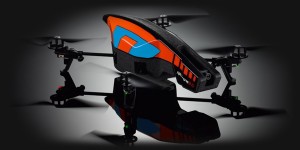Damage by Watching: Domestic Drones & Privacy
Jeremy Bentham, a leading 18th-century utilitarian thinker, advocated the panopticon prison, where convicts would be placed under constant surveillance by a central control station. The most notable critique of the panopticon prison model came from philosopher Michel Foucault, who viewed it as integral model for a “disciplinary society.”
What Bentham did not acknowledge is that constant surveillance is a form of torture and that shame and loss of dignity go along with constantly being seen and observed.
Fortunately, Bentham’s misguided effort to rehabilitate criminals by keeping them under 24-hour surveillance did not take hold, and today even most zoos provide some privacy for their animals. Not so long ago, people scoffed at the depiction in George Orwell’s late novel 1984 of cameras observing an individual’s every movement and word, even within their own homes.
Today, however, for a generation that regularly sees police helicopters hovering over urban neighborhoods and millions of surveillance cameras in stores and other public places, we may now stand at a point where the government’s ability to spy on us even at home becomes a reality. Would you like to be filmed and recorded by a government machine while taking a shower, undergoing a medical examination, or doing other sensitive activities during which you would expect privacy?
Drones, sometimes called unmanned aerial vehicles (UAVs), are remotely controlled electronic devices that can observe activity while remaining undetected. Large surveillance devices, including spy satellites, can already provide remarkably clear photographs of ground targets, although they cannot see inside houses or hear speech and other sounds. Remote-controlled drones, which look like small planes or helicopters (and can be operated by people nearby or on the other side of the world), now have the capacity to identify individual humans and are capable of intercepting electronic communication. They have grown progressively smaller; some drones now have wingspans as wide as 10 feet, while drones that operate for an hour or two and can be launched by an individual on the ground have wingspans as narrow as 6.5 inches.
Federal authorities are seeking to license thousands of domestic surveillance drones to be launched as soon as 2015. Legal experts are suggesting that our privacy will be called into question on an unparalleled scale. To this point 24 civil liberties and privacy organizations have submitted a formal petition to the US Customs and Border Protection demanding that the agency cease the flights of all Predator drones along the borders until clear legal guidelines have been established.
The case for using drones is easy to make. They can make society safer by providing better perspective and evidence, which means more harm may be avoided. Even so, just as with wiretaps and other surveillance methods, the use of drones for specific missions must be carefully regulated by the legal apparatus.
Even with court and other regulations, domestic drone use has an enormous potential for abuse. Consider the already frightening capabilities of drones:
*The ARGUS wide-area surveillance system of drones can monitor all moving people and objects in an area nearly 39 square miles wide. When coupled with the “Persistics” system, it can simultaneously track literally thousands of “targets” and their activities.
*Drones are inexpensive, encouraging their proliferation. While police helicopters can cost $500,000-$3 million apiece and are expensive to fly and maintain, drones may eventually cost as little as $100 each. Since there is little expense involved, there is a greater incentive to use drones more often, whether or not there is a critical need. In addition, some drones are small enough to hover just outside windows or other spaces that a noisy helicopter could never risk.
*Drones for private use are already available, and they are inexpensive. The Parrot AR.Drone 2.0, for example, sells for about $300, and features cameras that face forward and downward and can be controlled and viewed in real time via an iPad. Drones can already be equipped with tear gas and rubber bullets, and manufacturers are requesting authorization to build them. How long before someone manages to equip these machines with a weapon or bomb that could be detonated with no risk (and hardly any expense) to the terrorist?
*A 2012 law passed by Congress authorized the Department of Homeland Security to offer grants to local law enforcement authorities so they could purchase drones. On the state level, legislation to authorize domestic drones has been introduced in 35 states, and is still active in 30 states. Legislation has passed at least the committee stage in eight states.
*There are estimates that by 2020, 30,000 domestic drones may be in use.
There is a further danger that drones will continue the infamous legacy of weapons developed for war crossing over into civilian society. Many people remember the Thompson submachine gun as the weapon of choice for gangsters (and in response, law enforcement) during the Prohibition era, but few remember that it was developed during World War I for military use. Similarly, the Vietnam War-era AR-15 semi-automatic rifle and its variants have become the weapons of choice in recent mass shootings in Newtown, Aurora, and other places. We must always use caution when introducing military devices into society, and consider who might eventually get their hands on that technology.
No one’s civil liberties need to be violated if drone surveillance is done properly. Additionally, drones can save government money — the technology is relatively inexpensive compared to employing more police officers or building more vehicles. Criminals can be under surveillance more effortlessly.
But our goal as a society isn’t safety alone. We are also deeply concerned with privacy, dignity, and freedom. There would be great losses to becoming a “surveillance society” where every word and movement is tracked, recorded, and scrutinized.
There have been important developments around the country to regulate the use of drones. Many limits should be placed upon the use of drones. A Rhode Island bill, for example, would prevent drones from carrying weapons, limit the time a drone could be used against an individual, notify those targeted that they had been subject to surveillance, and provide legal redress for anyone who had been subjected to illegal surveillance by a drone. This year, Seattle returned the two drones it had purchased without using them after its mayor decided to prohibit their use. A bill has been introduced in Congress to forbid the use of drones without a warrant. Public opinion may also turn against aggressive use of domestic drones. A Gallup poll released in late March 2013 revealed that 79 percent of Americans oppose the use of drones to assassinate American terrorists living in this country. There should be audits and oversight to be sure that the surveillance procedures are not abused.
There are two relevant Jewish prohibitions here: hezek re’iah (visual surveillance—damage by watching) and hezek shemiyah (aural surveillance — damage by listening). While there is no physical contact, they are still considered damage for which one is legally liable. Rabbi Norman Lamm wrote back in 1967: “Unauthorized disclosure, whether the original information was received by complete consent or by illegal intrusion, whether ethically or unethically, remains prohibited by the halachah.”
Israeli Supreme Court Justice and talmudic scholar Menachem Elon, of blessed memory, was vocal about this issue and argued in 1994 that “The protection of privacy in Jewish law goes beyond prohibiting the observation of another’s activities. There is a legal duty to prevent the possibility of observation that would infringe another’s privacy; the mere existence of such a possibility inhibits the freedom of an individual to act as he wishes in his home or courtyard.”
I hope you’ll join me to ensure that drones are not used in such a fashion by signing the petition to the deputy commissioner of the US Bureau of Customs and Border Protection sponsored by the Electronic Privacy Information Center, that calls on the government to suspend the use of drones until rules are established protecting the public’s right to privacy. Write to your Senators and Representative to see where they stand on pending legislation on drone use and keep track of your state’s legislation.
There are already industry groups and manufacturers lobbying to promote the indiscriminate use of drones. It is critical that we all raise our voices to see that this emerging technology does not become a monstrous violation of privacy. We must make sure society and technology can help us do that. But this must be heavily regulated with strong checks and balances. Using drone technology runs the risk of losing all personal privacy and puts civil society, no less than the individual, at risk.
Rabbi Shmuly Yanklowitz is the founder and president of Uri L’Tzedek, the senior rabbi at Kehilath Israel, the founder and CEO of the Shamayim V’Aretz Institute and is the author of “Jewish Ethics & Social Justice: A Guide for the 21st Century” In 2012 and 2013, Newsweek/The Daily Beast named Rav Shmuly one of the “top 50 rabbis in America”.
![[the current issue of ZEEK]](../../image/2/100/0/5/uploads/leftistethicistgraphic-52842c6a.png)
- 5000 Pages of Zeek
- Founded in 2001, Zeek was the first Jewish online magazine, and we have over 5000 pages online to prove it, all available free of charge. Read more in the Archive.
More articles by
Rabbi Shmuly Yanklowitz
More articles in



